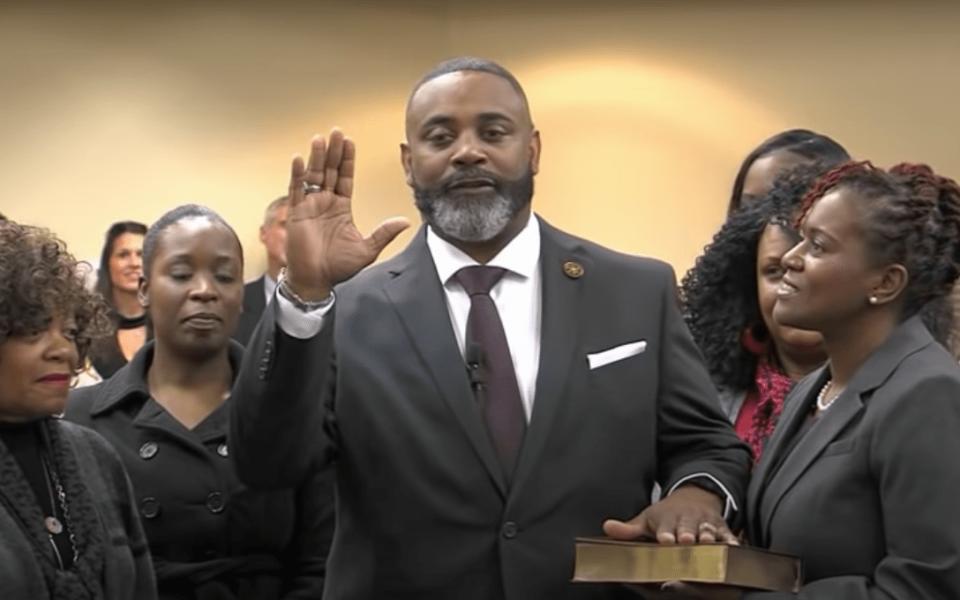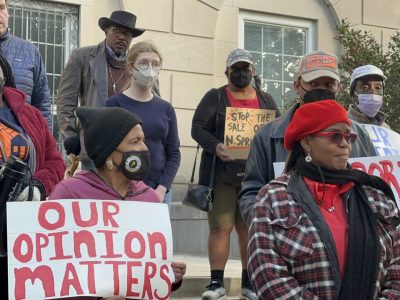Danny Rogers takes the oath to become Guilford County sheriff in December 2018. (courtesy of Guilford County Sheriff’s Office)
Before he became Guilford County sheriff, Danny Rogers met with a woman whose daughter had recently died in Greensboro Jail Central during his 2018 campaign. Then a candidate seeking to unseat incumbent Sheriff BJ Barnes, Rogers passed along information during that meeting from a one-time detention officer indicating that the woman’s daughter had been caught with drugs in her housing unit and had overdosed.
The impression that Tasharra Thomas overdosed — and also that she was physically abused in jail — in the days leading up to her May 2, 2018 death have persisted. Now, Rogers is the sitting sheriff and a defendant in a wrongful-death lawsuit filed by Thomas’ estate. As a defendant alongside former sheriff Barnes, the agency’s insurer and a private company that provides medical services to the jail, Rogers is arguing, contrary to his previous statement, that Thomas did not overdose. His office has also insisted that Thomas was not physically abused.
The position taken by the sheriff’s office is backed up by the autopsy. The autopsy states that “no injuries were found that contributed to death.” And while the autopsy notes the presence of fentanyl and a trace amounts of methamphetamine in Thomas’ body, the report concludes: “Based on autopsy findings, toxicology results, and circumstances surrounding the death, as currently understood, the cause of death is sepsis due to infective endocarditis due to chronic injection drug use.”
During his meeting with Rochelle Thomas-Boyd, Tasharra Thomas’ mother, in the spring of 2018, then-candidate Rogers contacted an unidentified detention officer to try to glean more information about the circumstances surrounding Tasharra’s death. The lawsuit filed by Thomas’ family alleges that while Rogers was in Boyd’s presence, the officer read from an official record and told Rogers that Tasharra had died in jail from a drug overdose.

In a recording of the meeting that Thomas-Boyd provided to media outlets, Rogers can be heard speaking, with Whitney Houston’s “I Wanna Dance With Somebody” playing loudly in the background.
“He said she came in on a Sunday night and was caught with pills in a shakedown on Monday,” Rogers says. “She must have OD-ed on more pills last night. She had just saw a nurse and took meds, and vitals checked an hour before she was found unconscious. After [inaudible] EMS couldn’t get her pulse, they put her on a bed and covered her up with a sheet. Officers had to do two rounds for two hours until the coroner came….”
It’s at that point that Rogers interrupts himself and asks Boyd: “Have you heard that?”
Hearing that she hadn’t, and Rogers offers: “I’m gonna send you this, okay?”
As noted in the lawsuit, Rogers never followed through with sending a report or any other document to substantiate the claims.
Through the legal staff at the Guilford County Sheriff’s Office, Rogers said he had not been reading from a report during his meeting with Thomas-Boyd, but rather, “as best he can recall, he was reading from an email or text message sent to him by a former detention officer who was no longer employed by the sheriff’s office at the time Ms. Thomas died in May 2018.”
A statement provided to TCB by the sheriff’s office goes on to say that “the former officer incorrectly claimed to have knowledge concerning pills being found in Ms. Thomas’ cell” two days prior to Thomas’ death, and that he “speculated (without any facts) that Ms. Thomas ‘must have overdosed on more pills’ on the day of her death.” The statement bluntly concludes: “That officer is wrong.”
Explaining a second recording obtained by TCB, the sheriff’s office said Rogers made a phone call to the former employee and asked him “to provide further information so that these claims could be verified. Not surprising, the former employee never did.”
The sheriff’s office provided a report to TCB on Tuesday that indicates, contrary to the information Rogers shared with Boyd in the spring of 2018, that no drugs were found during a search of the housing unit where Thomas was housed.
Entitled “Housing Pod 7A Shakedown,” the report indicates that a search was conducted on Monday, April 30, which turned up “no extra items.”
“There was no excess county issued items found during the shakedown,” the report also states. “All trash was removed from the housing unit. All inmates were strip searched in their cells. The recreation yard, staff bathroom, visitation room, janitor closets, multi-purpose room, inmate attorney room and dayroom were also searched with no problems noted in these areas. The shakedown went rather smoothly with the diverse individuals currently housed in the unit.”
The report is dated April 30, the same day as the search and two days prior to Thomas’ death. The names of staff, including the master corporal who completed the report, are redacted from the copy provided to TCB.
In a written response to questions from TCB, the sheriff’s office said Rogers agreed to meet Thomas-Boyd shortly after her daughter’s death “to give her the opportunity to express her concerns to him and to determine, as part of his campaign for sheriff, whether those concerns could be substantiated.”
The sheriff’s office declined to provide the name of the former detention officer to TCB, but said he “will be identified during the course of the pending lawsuit and Ms. Thomas-Boyd’s attorney will have the opportunity to depose that person under oath.”
The sheriff’s office did not respond to questions from TCB about whether then-candidate Rogers followed up with Thomas-Boyd to explain that he was unable to verify the claims about her daughter getting caught with drugs and experiencing an overdose, or whether he followed up with her to inform her that no report ever surfaced to back the claims.
The statement provided by the sheriff’s office asserts that the autopsy, jail surveillance video and written search report “show that Ms. Thomas did not get access to illegal drugs in the jail and that she did not overdose on drugs while in jail.”
Thomas-Boyd also provided media outlets with a five-second video that scans across a photograph showing what appears to be bruises on Tasharra’s upper body and trauma around her left breast. The video also shows a V-shaped sutures across her chest to close up an incision. TCB is not publishing the video out of respect for the deceased.
Thomas-Boyd declined to comment on the record to TCB, but the lawsuit mentions that she “was able to secure video and pictures of Tasharra’s body while it was in the morgue.” The suit provides a graphic itemization of apparent injuries: “Tasharra’s nipple had been ripped off; she had what appeared to be unexplained bite marks on her body; some of her hair had been ripped out; her wrists appeared to be bruised as if she had been handcuffed; she had other bruises and contusions; and some of her bones appeared to be broken.”
In a statement to TCB, the sheriff’s office disputed the assertion in the lawsuit that the image was taken at the morgue, noting that the sutures suggest it was taken after the autopsy, which was performed at the Office of the Chief Medical Examiner in Raleigh.
“It is not unusual for a body to show post-mortem signs of bruising,” the sheriff’s office said. “This can occur due to the pooling of blood (which is no longer circulating) or the post-mortem handling of the corpse.”
The autopsy was performed in May 2018 by Dr. Michelle Aurelius. Since then, Dr. Aurelius has been promoted to the position of chief medical examiner for the state of North Carolina. In response to a request for an interview with Dr. Aurelius, a spokesperson for the state Department of Health and Human Services said no staff was available for comment.
The sheriff’s office said in a statement to TCB that a crime scene investigator took photos of Thomas’ body on May 2 while it was still in the jail and before it was taken to the morgue at Moses Cone Hospital. The photos show long-term scarring from chronic injection drug use, but none of the bruising seen in the post-autopsy photo, according to the sheriff’s office. The statement also said a multi-colored braid was still in place.
The agency said it was making an exception to its typical practice of not commenting in detail on pending litigation in this case “because the estate’s claims that Ms. Thomas was physically abused by our officers and that she overdosed on illegal drugs while in jail are all untrue.
“While factual disputes are not uncommon during a lawsuit,” the statement concludes, “particularly the allegations that Ms. Thomas was physically abused and/or overdosed in jail, are not only untrue, but unnecessarily put our deputies and officers at risk.”
First statement from Guilford County Sheriff’s Office:
This pertains to the audio on the two short video recordings provided to Triad City Beat by the estate of Tasharra Thomas. Thank you for sharing both recordings with the sheriff’s office. We have reviewed those recordings, and do not believe that an interview with the sheriff is necessary as your questions can readily be answered via this email.
As an initial observation, both recordings were difficult to hear and it is unclear whether the audio clips provided by the Estate accurately reflect everything that was said during those conversations.
From what we understand, the estate claims that the first audio recording has Sheriff Rogers reading from an official sheriff’s office report which allegedly reported that pills were found in Ms. Thomas’ cell during a cell search (sometimes referred to as a “Shakedown Search”). As with many of the other claims in the Estate’s lawsuit, these allegations are also incorrect.
First, the conversations reflected on the two recordings, took place in or near the spring of 2018 when Sheriff Rogers was still running for the Office of Sheriff. In other words, these recordings were made months before he was elected. Because Sheriff Rogers was not even in office at the time the recordings were made, he did not have access to sheriff’s office reports concerning Ms. Thomas at that time.
Second, on the first recording (which lasts for 1 minute and 9 seconds), Sheriff Rogers was not reading from a report made by the Sheriff’s Office. Instead, as best he can recall, he was reading from an email or text message sent to him by a former detention officer who was no longer employed by the Sheriff’s Office at the time Ms. Thomas died in May 2018. This former Officer incorrectly claimed to have knowledge concerning pills being found in Ms. Thomas’ cell during the search on Monday, April 30, 2018. As reflected on the first recording starting at the 25 second mark, that former employee also speculated (without any facts) that Ms. Thomas “must have overdosed on more pills” on Wednesday, May 2, 2018. That former officer was wrong. In fact, on the second audio recording that the Estate provided, you can hear Sheriff Rogers telephone this former employee and ask him to provide further information so that these claims could be verified. Not surprising, the former employee never did. In short, Sheriff Rogers was not reading from a GCSO report, but rather an email or text message sent to him by a former employee.
Third, a copy of the actual report for this search is attached to this email. The report shows no drugs or contraband were found in any of the cells in that housing unit (known as “Pod 7A”). Ms. Thomas was in cell 7A-15 during her stay and the attached report reflects that nothing was found in her cell. The names of our officers and confidential, medical information concerning another inmate who was in Cell 7A-11, has been redacted from the report to protect their privacy.
Fourth, the search of Ms. Thomas’ cell is recorded on the Jail video that was made public by the Sheriff’s Office. You have a copy of that video, and you can view the search for yourself. The search takes place shortly before 8:00 p.m. on Monday, April 30, 2018 — two days before Ms. Thomas died. The video shows that this was a routine search and establishes that a Sheriff’s K-9 (dog) was not present. The video shows that the search of Ms. Thomas’ cell was completed in just 2 minutes and 59 seconds (it starts at 7:53:38 p.m. and ends at 7:56:37 p.m.). Five female Detention Officers are present during the search and the video shows that none of those Officers react as if any pills or other contraband had been found in Ms. Thomas’ cell.
Fifth, if Ms. Thomas had overdosed on pills while at the Jail as the Estate claims, the medical examiner would certainly have detected it and commented upon it during the autopsy. As you know, in the autopsy report, the medical examiner makes no mention of an overdose.
Sixth, if illegal or unauthorized narcotics (pills) had been found in Ms. Thomas’ cell, she would have been criminally charged by one of our deputies. The fact that no such criminal charges were filed against Ms. Thomas, is further evidence that no pills were found in her cell.
As you know from our past dealings, the sheriff’s office does not typically comment in detail on pending litigation. We have made an exception in this case, because the estate’s claims that Ms. Thomas was physically abused by our officers and that she overdosed on illegal drugs while in Jail are all untrue. While factual disputes are not uncommon during a lawsuit, the claims made here by the estate, particularly the allegations that Ms. Thomas was physically abused and/or overdosed while in Jail, are not only untrue, but unnecessarily put our Deputies and Officers at risk. As such, these allegations required the detailed and factually-based responses made by the Sheriff’s Office to your inquiries.
Second statement from Guilford County Sheriff’s Office:
Thank you for your emails earlier today. Your first email today contains the following observation and question:
“Additionally, the estate provided Triad City Beat with a short video depicting Tasharra Thomas’ body in the morgue. The recording shows multiple bruises and contusions, as well as a cord-like line that forms a ‘V’ across Ms. Thomas’ chest. I would like the sheriff’s office to explain how these bruises appeared, and what the cord-like line is.”
The estate provided the GCSO with the same video excerpt (but, again, not the entire video). This video was not taken at “the morgue” at Moses Cone Hospital before the autopsy. Instead, the “cord-like V” that you refer to in your email is clearly the sutured autopsy incision made by the medical examiner. In other words, the video sent to you by the estate shows the condition of Ms. Thomas’ body at some point after the autopsy was performed.
We know from the medical examiner’s report that the autopsy was performed on May 5, 2018 — three days after Ms. Thomas died. So the video provided to you by the estate shows the condition of Ms. Thomas’ body at least three days (if not more) after her death, and at least three days (if not more) after the sheriff’s office relinquished control of the body to the medical examiner. By the time this video was taken, Ms. Thomas’ body had already been transported by other individuals to and from the Medical Examiner’s Office in Raleigh and subjected to the physical rigors of an autopsy.
Moreover, it is not unusual for a body to show post-mortem signs of bruising. This can occur due to the pooling of blood (which is no longer circulating) or the post-mortem handling of the corpse. I would strongly urge you to consult a pathologist on this issue before you write your article.
Furthermore, a crime scene investigator took photographs of Ms. Thomas’ body on May 2, 2018, while it was still at the jail and before it was taken to the morgue at Moses Cone Hospital. The sheriff’s office provided copies of those photos to the estate months ago. Those photos depict the long-term scarring noted by the medical examiner which resulted from Ms. Thomas’ chronic injective drug use, but none of the bruising the estate claims is shown in the video. Those CSI photos also show the multi-colored braid of hair was still in place while Ms. Thomas’ body was at the jail and awaiting transport to the morgue. Out of respect for the deceased, the sheriff’s office will not publish photos of Ms. Thomas’ body, but the estate can do so. Those photos, however, clearly contradict the estate’s claims that Ms. Thomas was physically abused while in the Jail.
Sheriff Rogers met with Ms. Thomas-Boyd in the Spring of 2018 when he was still a candidate for the Office of Sheriff. He did so to give her an opportunity to express her concerns to him and to determine, as part of his campaign for sheriff, whether those concerns could be substantiated. The former employee who communicated with Sheriff Rogers will be identified during the course of the pending lawsuit and Ms. Thomas Boyd’s attorney will have the opportunity to depose that person under oath.
Join the First Amendment Society, a membership that goes directly to funding TCB‘s newsroom.
We believe that reporting can save the world.
The TCB First Amendment Society recognizes the vital role of a free, unfettered press with a bundling of local experiences designed to build community, and unique engagements with our newsroom that will help you understand, and shape, local journalism’s critical role in uplifting the people in our cities.
All revenue goes directly into the newsroom as reporters’ salaries and freelance commissions.





Leave a Reply